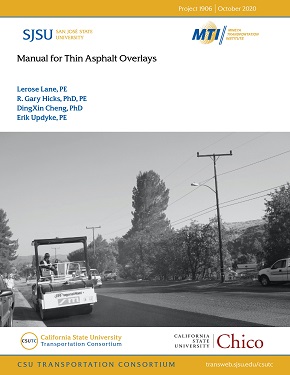- 408-924-7560
- mineta-institute@sjsu.edu
- Donate
Manual for Thin Asphalt Overlays
This manual presents best practices on project selection, mix design, and construction to ensure a superior product when constructing thin asphalt overlays. Experience shows these treatments provide excellent performance when placed on pavements in fair to good condition using proper construction techniques. Though sometime referred to by other names, thin asphalt overlays have been widely used for pavement preservation throughout the world for over 50 years.
Limited infrastructure funding at the local, state, and federal levels has resulted in greater emphasis on the use of pavement preservation techniques to extend pavement life and reduce maintenance costs. Thin asphalt overlays are one of many preventative maintenance treatments. Thin asphalt overlays are placed directly on existing pavement and can range from 1/2 inch to 1 1/2 inches in thickness. Thin asphalt overlays have proven to be an economical means for maintaining and improving the functional condition of an existing pavement since the 1960s.
Specifically, this manual provides guidance for engineers regarding where and when to use thin asphalt overlays including: (1) Types and variations of thin overlays; (2) Materials and the design process; (3) Construction; (4) Quality Assurance; and (5) Troubleshooting. This chapter by chapter guidance enables an Agency’s engineers to design and construct a successful thin asphalt overlay project to completion.
This manual is one of four new manuals prepared by the California Pavement Preservation Center (CP2Center) using funding from California Senate Bill 1 (SB-1), passed in April 2017. The other three manuals provide detailed design and construction information for (1) chip seals, (2) slurry surfacing, and (3) Cape seals. The creation of these manuals was a task funded entirely from SB-1 monies for the purpose of disseminating training and technical information on highway pavement preservation to local agencies throughout California.
LEROSE LANE, PE
Lerose Lane, PE is a Senior Pavement Preservation Engineer who has worked for the California Pavement Preservation Center (CP2C) since August 2010. Her work involves observing pilot project construction for a wide variety of preservation strategies, including: Rubberized Chip Seals, Scrub Seals, Reconstruction with Rubberized Hot Mix Asphalt Concrete, and Double Chip Seals. She graduated from CSU, Chico, in 1970 with a B.S. degree in Civil Engineering. Since that time, she has worked for several agencies including Caltrans in various capacities including District Materials Engineer, Office Chief in Design, and Senior Construction Engineer, as well as being a Resident Engineer for a wide variety of projects. She has been a Professional Engineer in the State of California since 1975.
R. GARY HICKS, PHD, PE
Dr. Hicks is currently program manager for the CP2 Center at CSU Chico. Prior to joining the Center, he taught at Georgia Tech and Oregon State University for 30 years, rising to a Distinguished Professor of Civil Engineering and the Associate Dean for Research in the College of Engineering. He retired from OSU in 1997, and upon retirement embarked on a consulting career with MACTEC Engineering (now Wood LLC) providing on-call consulting services to the California Department of Transportation and other organizations in the area of asphalt pavements. As a part of the Caltrans project, he led the development of the MTAG and helped establish the CP2 Center in 2006. He is a registered Civil Engineer in the states of California, Oregon, and Alaska.
DINGXIN CHENG, PHD, PE (TEXAS)
Dr. DingXin (Ding) Cheng is a Professor in the Department of Civil Engineering at the California State University, Chico, Director of the California Pavement Preservation (CP2) Center, and Director of the Tire Derived Aggregate Technology Center. He has worked actively with the CP2 Center since he joined the Department of Civil Engineering at CSU, Chico, in 2006. He obtained his PhD in the areas of pavement materials and transportation from Texas A&M University in College Station, Texas in 2002. He worked in private industry for Parsons Brinckerhoff in Houston, TX before joining Chico State. He has extensive experience in hot mix asphalt (HMA) materials and pavement preservation on both asphalt and concrete pavements. He has more than 55 peer-reviewed publications related to pavement materials and preservation presented at Transportation Research Board, AAPT, ASCE, and other conferences. Ding has co-managed or managed more than $7 million of research projects funded by the California Department of Transportation (Caltrans), California Department of Resources Recycling and Recovery (CalRecycle), Metropolitan Transportation Commissions (MTC) of San Francisco Bay Area, and other agencies and industry. He is a registered civil engineer in the state of Texas.
ERIK UPDYKE, PE
Erik Updyke, PE is a Senior Pavement Preservation Engineer who has worked for the California Pavement Preservation Center since April 2020. Erik is also a Specialist with the City and County Pavement Improvement Center at the University of California, Davis, and a consultant to local agencies on contract documents and pavement preservation. Erik retired from the Los Angeles County Department of Public Works after 36 years in the Road Maintenance, Design, and Construction Divisions. From 2005 to 2019, Erik was the APWA Co-Chair of the Greenbook Committee of Public Works Standards, Inc. Erik has presented numerous seminars on the Greenbook throughout Southern California and also spoken on pavement preservation at several conferences. Erik has a B.S. in Civil Engineering from the University of Maine and an MBA from Long Beach State University. He is a Registered Civil Engineer in California and a Professional Engineer in Maine.
-
Contact Us
San José State University One Washington Square, San Jose, CA 95192 Phone: 408-924-7560 Email: mineta-institute@sjsu.edu






